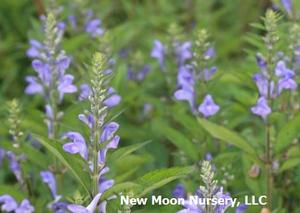New Moon Nurseries
Scutellaria incana
hoary skull cap
Native to North America
FIRST IMPRESSIONS: Scutellaria incana is a lovely wildflower with erect pubescent stems clothed in toothed ovate gray-green leaves. In late spring, stems terminate in showy open racemes of tubular two-lipped blue-violet florets. Plants thrive in open woods or sunny meadows and in moist rich soils or in average garden soils.
HABITAT & HARDINESS: This species is native to the eastern United States from New York to Wisconsin and south from Florida to Texas.
Scutellaria incana occurs in rocky open woods, pinelands, wooded slopes along streams or rivers, woodland edges and clearings, dry wooded bluffs, ravines, shaded upland meadows, thickets and shaded roadsides.
Hardy from USDA Zones 4-9.
PLANT DESCRIPTION: Scutellaria incana is a bushy rhizomatous perennial with square green or purplish stems. The stems, undersides of leaves and florets have a fine whitish pubescence that is downy but not sticky or glandular.
Pairs of opposite ovate leaves with short petioles are arranged along the stems. Blades are 3” long and up to 1½” wide with rounded teeth and a pointed tip.
From mid to late summer, the upper stems terminate in 6” spikey flower racemes. The racemes are upright with closely spaced pairs of florets.
The florets are salvia-like and about ¾” long with a soothing blue-violet color. They are tubular with 2 lips. The upper lip is hood-like with a margin that curls back and the lower lip has a white blotch. Blooming begins in mid-summer and continues for 4-6 weeks.
The calyx at the floret base resembles a tiny medieval helmet or skullcap. It persists and serves as a unique shield or dish shaped vessel that holds 2-4 dark rounded nutlets. As the seed matures, the calyx changes from green to brown.
Plants are usually 2-3’ tall with a spread of 1-2’. They expand into small colonies from underground rhizomes.
CULTURAL & MAINTENANCE NEEDS: Scutellaria incana grows best in dappled sun in average well drained slightly acid sandy or clay soil.
Plants tolerate heat, drought, shade, poor infertile soils, rocky or gravelly soils, moderate salinity and full sun if soil is moist.
This species is fairly pest resistant and unpalatable to deer and rabbits.
LANDSCAPE USES: Scutellaria incana is a perfect candidate for the Perennial Border or Wildlife Garden. It is also a useful Accent, Grouping or Mass Planting. Plants provide Showy Blooms in Container Plantings, Cottage Gardens, Deer Resistant Plantings, Meadows, Rock Gardens, Water-wise Landscapes, Low Maintenance Plantings and Shade Gardens.
COMPANION & UNDERSTUDY PLANTS: Try planting Scutellaria incana with Aster laevis, Blephilia ciliata, Echinacea purpurea, Spigelia marilandica, Solidago juncea, Carex albicans and Waldsteinia fragarioides.
Scutellaria ovata is a bit shorter and less sun tolerant but can be substituted in shaded sites. Agastache foeniculum is another worthy substitute that has similar flower color and foliage, summer bloom time and comparable cultural needs.
TRIVIA: Flowers are pollinated by bumblebees and are also visited by hummingbirds and butterflies. Foliage is bitter and unpalatable to mammalian herbivores.
Scutellaria is from a Latin word meaning “little shield” and describing the odd shape of the persistent calyx. The specific epithet incana means “gray” and refers to the very fine pale downy hairs or canescence that clothe parts of the plant. The hairs on the florets are so fine that they may be invisible unless magnified.
Height:
2-3 ftSpread:
1-2 ftSpacing:
2 ftUSDA Hardiness Zone:
4-9Bloom Color:
Lavender-BlueScutellaria incana Characteristics
Attracts Wildlife
- Pollinators
- Hummingbirds
Attributes
- Drought Tolerant
- Dried Flower
- Coastal
- Clay Soil
- Naturalizing
Exposure
- Light Shade
Deer Resistant
- Deer Resistant
Flowering Months
- September
- August
- July
Foliage Color
- Green
Growth Rate
- Medium
Season of Interest (Foliage)
- Summer
- Spring
Soil Moisture Preference
- Dry to Moist
